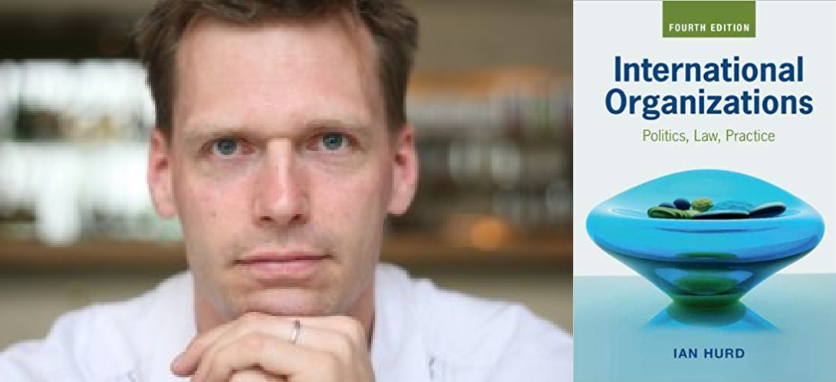
Ian Hurd discusses the new edition of his book on international organizations
September 16, 2020
Ian Hurd, Professor of Political Science and Director of the Weinberg College Center for International and Area Studies at Northwestern, wrote the book on international institutions — quite literally. His International Organizations: Politics, Law, Practice is among the scholarly reference points on the subject. Originally published in 2012, Cambridge University Press has just published the 4th Edition of the book.
Simon Chesterman, editor of the Asian Journal of International Law, calls International Organizations "one of the most accessible and insightful textbooks on this important topic. Offering a world tour of the UN, the WTO, and other key institutions, it dives deeply into the daily practice of those institutions with thoughtful and thought-provoking examinations of the interplay of law and politics."
Steven R. Ratner, Bruno Simma Collegiate Professor of Law at the University of Michigan Law School, says: "Combining theory with many real-world examples of different IOs in action, [Hurd] offers an ideal introduction to the field for students in multiple disciplines. By viewing IOs as actors, fora, and resources, he demonstrates their multiple roles — and the challenges they face — in global affairs today."
In this brief Q & A, Hurd discusses the new edition of the book, its relevance to the current global situation, and how it informs a new research project he is spearheading on the COVID pandemic and global governance.
The 3rd Edition of International Organizations came out three years ago. What new ground/themes does the 4th Edition cover?
The new edition is updated to address some of the most pressing events in world politics in recent years. It looks directly at how international institutions have responded to pollution, global warming, and environmental collapse, and it includes new case studies involving Brexit and other current events where the law and politics of international organizations are at center-stage.
It also has a new focus on global migration. With so many people around the world on the move, we need to understand the institutions and rules that govern how they move, where they can stay, and who decides their fate. The new chapter looks at the International Organization for Migration, the Convention on Refugees, and the High Commissioner for Refugees. The effort of governments to prevent migration into their countries shows the hard edge of international organizations: the universal language of rights and freedom gives way as these institutions are deployed by governments prevent people from moving from one country to another. To understand how this happens we need to look closely at the rules and structure of these crucial international organizations.
With nationalism and isolationism on the rise globally and with various countries pulling out of supranational and multilateral bodies, is the study of international organizations relevant to what’s going on in the world?
The main theme of the book is that international organizations are tools that people use to try to accomplish their goals. For instance, governments use the World Trade Organization to shape trade rules in favor of their interests and they use the International Court of Justice to constrain the policy choices of other governments.
All governments engage in this kind of political maneuvering, and international organizations are a key device in international politics. They are useful to governments of all persuasions, and to activists, firms, and civil society groups alike. As a result, the United Nations, the EU, and the other international institutions discussed in the book will remain relevant in international affairs because governments find them useful as tools, as scapegoats, or as ideals.
You’re heading up a new research initiative on Global Governance in the Age of COVID. How does your scholarship on the politics of international institutions inform this new project?
The COVID pandemic is helping show both the need for global institutions and the weaknesses of the institutions that we currently have. The mythology of international organizations is that they are designed to deal with problems that no country can handle alone, such as over-fishing on the high-seas, cross-border pollution, or infectious diseases. With the COVID pandemic, we confront a dramatic example of such a problem and global institutions are showing what they can and cannot do: The World Health Organization, for instance, did well communicating the dangers of the new virus in the early months but its warnings were not taken seriously enough by governments. This pandemic presents an urgent challenge that is revealing what international organizations can and cannot do. My book helps explain how these powers and limits are created by the legal rules of the organizations.
The terrain of international politics today is defined by a blend of government power, corporate power, and informational power. The matrix of authority that shapes how people live is subtle and diversified; it integrates public and private forms of governance as well as national, local, and transnational institutions. The international organizations I examine in the book are an important strand in the network of global power and in order to get a clear sense of the contemporary world we must understand the place of these organizations. The book offers readers a guide to how international organizations are made, what they do, what they can’t do, and how they are used. It illuminates one thread in the tapestry of global authority and offers readers resources for making sense of international affairs through a broad and dispassionate lens.
International Organizations: Politics, Law, Practice, 4th Edition (Cambridge University Press, 2020)
